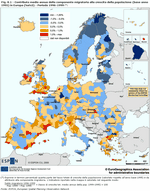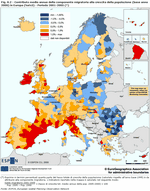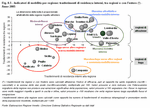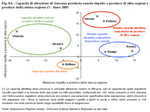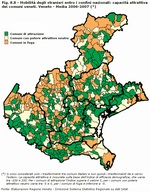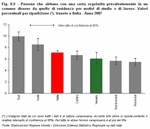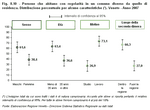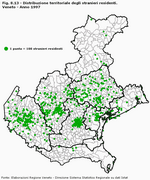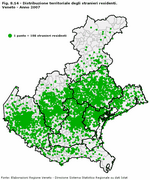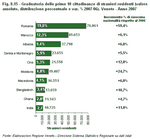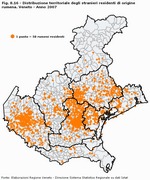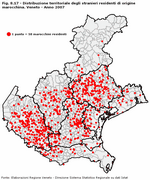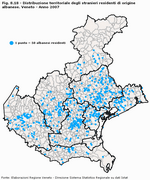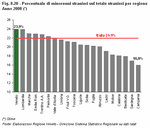The migrant population from past to present
|
Europe tends to be characterised by overall population growth. However, a closer look at the different areas does reveal differences between Eastern and Western Europe. The central western regions can boast a growing population, which is mainly thanks to new arrivals from abroad, whereas the population is decreasing in Eastern Europe and in some Scandinavian areas. Regions in which the capital city is situated tend to be subject to substantial population growth; this is also true in the countries with lower overall population growth.
This situation is very different from that of past decades and is only partly due to natural causes. Nowadays migration plays a major role, and in some areas this has balanced out the negative natural growth trend. A comparison between immigration at the end of the 1990s and at the beginning of the new millennium shows that significant changes are afoot. During the first five-year period under consideration, increases and decreases in migration were dotted throughout all the regions despite the lower concentration of positive net migration in the regions in Eastern Europe. After the year 2000, however, the differences between East and West have become much clearer: many eastern regions have a negative migration balance, except in the capitals, which continue to be a driving force for the country's economy, whereas the central western countries have a positive balance. Many of the Mediterranean regions, in Spain, France and Italy in particular, prove to be highly attractive to foreigners; we can also add Ireland, Cyprus and parts of England and Greece to this list. The number of foreigners in Italy has increased greatly; many other countries in Western Europe, such as Germany and France, have been through the same situation, but in Italy it has happened more recently. As a consequence of this late start, Italy still has a quite modest level of immigration, with much lower numbers compared to those countries where immigration has long been a part of their history. However, current growth trends lead us to believe Italy will soon find itself in a similar situation. (Figure 8.1) and (Figure 8.2)
It is true that, in times of peace at least, areas of emigration are worse off economically and less stable socially than areas of immigration. A look at Veneto over the years confirms this statement too. Through the changes seen in migration patterns we can see Veneto moving from a rural, more financially limited situation to becoming more solid economically and socially as it developed from a region of emigration into a region of immigration.
The turning point occurred towards the end of the 1960s: from 1968 on, net migration with other Italian regions began to be positive, followed shortly afterwards by positive migration from abroad. From here on, numbers of people arriving from other regions or from abroad (i.e. Italians returning home or, more often than not, new foreigners) are more numerous than those leaving. This confirms Veneto was becoming more attractive and able to offer new financial and employment opportunities. (Figure 8.3) Veneto saw another turning point at the beginning of the 1990s. With the exception of a few years that didn't follow the trend of the period, Veneto began to see an ever-larger influx of foreigners, meaning that net migration from abroad overtook domestic migration. Domestic migration remains lower still today. The registration of foreigners in municipal registers soared suddenly from 2000 in particular; this can be attributed to Italy's periodic introduction of measures to regularise foreign residents who were originally here illegally, as well as to economic factors in migrants' countries of origin and to the changes in Eastern Europe's political and economic situation. Arrivals from abroad contribute to containing the effects of a negative or slower natural growth rate, especially in some areas, and they constitute an indispensable resource for overall population growth. The population in Veneto also grew last year, reaching 4,832,340 inhabitants in 2007, a 1.2% increase compared to 2006; it is estimated the figure will exceed 5 million by 2012. The population is mainly concentrated in the provinces of Padova (18.8%), Verona (18.5%) and Treviso (18.0%). These provinces have also seen the highest population growth. Population density is 262.6 inhabitants per kmq for the region overall: Padova has the highest density with 424.8 inhabitants per kmq and Belluno the lowest with 58.1.
It is interesting to see how migration within Italy has developed through time: in the 1960s and 1970s individuals or whole families moved from the South towards the North, whereas now most movements within the country are of a much shorter range. The share of movements between regions has gradually reduced over time, to make way for more movements within the same region or province.
The reasons people move tend to differ: in general, medium- and long-range moves (between regions and abroad) are mainly linked to study or work, whereas moves over a shorter distance (within regions and provinces) are more often connected to certain personal events, such as marriage, separation or leaving the family home, which lead to changes in living arrangements. According to the latest available data, in 2005 in Veneto 22.5% of the population changed their place of residence, moving to another municipality in the same region. This share, compared to the national average of 16.9%, is the highest after Valle d'Aosta (24.2%) and Lombardia (23.9%). The local population of Veneto tend to move around; they are happy to move house over short or medium distances, but are not so willing to move to different regions. This trend has increased over the last ten years as in 1995 it involved 16.7% of the population. As far as longer-distance moves to another region are concerned, in Veneto in 2005 4 people out of every thousand (19,285) moved house to go and live in a different region. As can be imagined, the most popular destinations are neighbouring regions in North Italy: Lombardia (20.6%), Emilia Romagna (12.9%) and Friuli Venezia Giulia (11.8%) in particular. As for moves from other regions into Veneto (23,472), besides from Lombardia and Veneto's other neighbouring regions, most arrivals are from some of the southern regions, in particular from Campania, Sicilia, Lazio and Puglia. These regions have a tradition of moving over long distances. It is the 20-40 age group that mainly take part in these migrations. (Figure 8.4) If deletions from municipal registers are higher than registrations in a certain area this means that it is an area which people tend to abandon, and therefore it is an area which people from outside don't tend to be attracted to. Vice-versa, if the number of registrations is higher than the deletions it can be confirmed that the population of that area is growing thanks to the arrival of new people in higher numbers than of those leaving. This means that this area is a magnet for people looking for a place to settle. Based on this, we can create an index, commonly known as the index of migration effectiveness (Note 1), which takes into account both the forces attracting people to a region and those causing them to leave. In Veneto this index was 9.8 in 2005, a sharp decrease on the 22.8 recorded in 1996. It is still however an attractive area, but the gap between the numbers arriving and the numbers leaving has shortened over time. This is the reason for the decrease in the index figure. (Figure 8.5) Comparing mobility trends in the different Italian regions highlights large differences between them. Firstly, in many southern regions, the trend is to abandon the region, as the number of people leaving exceeds the number arriving. Those leaving a municipality in one of the southern regions, Molise, Sicilia, Puglia, Calabria or Basilicata in particular, tend to head out of the region altogether. Numbers moving within the region are fairly low. Campania stands out among the southern regions for the highest number of people leaving for other regions; it also has a high level of internal mobility. Emilia Romagna, Trentino Alto-Adige, Toscana and Marche are the most attractive regions for people to move to. Veneto, Piemonte, Lombardia, Valle d'Aosta and Friuli Venezia Giulia have the highest levels of mobility within their regional boundaries. The regions in the Centre and in the North have the most pulling power for foreign migrants; the regions in the South are less attractive in this respect. Umbria and Valle d'Aosta are at the top of this list; Veneto comes in eighth. A look at movements within Veneto shows differences in terms of attractiveness between the seven provinces. There are high numbers of changes in residence within the provincial boundaries, above all in Vicenza, Treviso and Verona; these types of movements involve over 20% of the population. This figure is slightly lower for Padova and lower again in the other provinces (less than 15% of the population). If we look at movements between provinces in Veneto and between provinces in other regions separately, we can see differences in what type of pulling power provinces hold. Verona and Padova attract new residents from other regions above all, whereas the opposite is true for Treviso and Rovigo, to which people mainly move from other Veneto provinces. Vicenza and Venezia especially do not attract people from other regions, while Belluno is the only one where numbers leaving are greater both in terms of inter-provincial and inter-regional migration. Venezia stands out as a magnet for migration from abroad. (Figure 8.6) Migration within migration
Foreigners play an increasingly important role in internal migration in Italy. We can talk about migration within migration (Note 2): foreign migrants leave their home countries and once they have reached Italy, they do not settle down immediately but continue their journey in order to find better living and working conditions.Despite the fact that overall most changes of residence within the nation are carried out by Italians, the number of foreign residents doing so is becoming ever greater. In Veneto in 2005 almost one out of every four people who changed their residence to another municipality within the region was a foreign resident (23.2%). This puts Veneto in third place in the regional rankings, after Umbria (24.3%) and Marche (23.4%). Just ten years earlier in 1996, the figure for foreign residents was only 6.2%. (Figure 8.7) Foreign residents are more likely to move within the territory than Veneto residents of Italian origin. Of the latter, 18.5 people out of one thousand moved home within the region in 2005; this contrasts to 81.2 foreign residents in Veneto, a figure which has increased in the last 10 years. Looking closely at the region, we can see which municipalities attract people to move there, and which most people move away from. The province of Padova is particularly attractive to foreign residents already living in Veneto, as are some areas of the province of Treviso. The southern areas of the province of Verona, up to some municipalities of Rovigo and Padova, plus the municipalities of Venice that border other provinces, also have some pulling power. In Belluno, the provincial capital and the outlying areas stand out. (Figure 8.8) If we take a look at long-range movements, i.e. outside regional borders, also in this case it is foreign residents who have more of a tendency to move. Out of one thousand foreign residents, 13 moved house from Veneto to other Italian municipalities, whereas only 3 out of one thousand residents holding Italian citizenship did so. As for those coming into the region, the index of migration effectiveness was 7.8 for Italians and more than double that for foreign residents (16.5). More than one home
New work and study patterns mean that more and more people have to take on a flexible lifestyle which can deal with the changes and increased mobility characterising life in our society. In terms of living arrangements as well, when work or study causes people to leave their families temporarily to live for a certain amount of time in a different place, the number of homes people have multiplies. Students or workers share their time between their home and the place they live for work or study and are therefore known as "Family commuters".People in southern Italy have a greater tendency to this kind of mobility than the rest of Italy where most people manage or prefer to study or work close to home, meaning that they can commute daily rather than having to spend a few days or longer in a place which is not their home. This trend can also be seen in Veneto where we have lots of small- and medium-sized enterprises spread throughout the region, and where the universities often have satellite sites. (Figure 8.9) Most of these people are workers as opposed to students, often male, generally young people who do not yet have a family of their own and still register their place of residence as their parents' home. Around 60% of them stay within the region, except for in the southern regions where there is a greater tendency to study or work in another region. "Family commuters" make up 6% of workers and students in Veneto; this is in line with average national figures and trends in other northern regions such as Lombardia, Friuli Venezia Giulia and Piemonte. In Veneto the people in this group fall into the same social group as those described above. (Figure 8.10)
Social and economic changes, which occurred in parallel with demographic changes, have transformed the region and the provincial capitals, which have always been at the heart of business life. Due to their central position, provincial capitals are able to attract settlers. Reasons for moving to the city include greater job opportunities, availability of services and increased access to leisure activities. However, the future population of cities depends on how accessible and how enjoyable they are to live in: everything depends on the efficiency of transport infrastructures and housing costs, as well as on economic development and employment.
In the 1990s many provincial capitals, including Veneto ones, saw a great number of people abandoning the cities, leading to a progressive urban migration to metropolitan hinterlands, causing business and residential areas to expand to create metropolitan archipelagos. The reasons behind this centrifugal territorial expansion can be pinned down to the search for cheaper housing with more space, to people being able to use private means of transport to move around, and to a desire to get away from the chaos and pollution of the metropolis in order to improve quality of life. Cities seemed to progressively become places to be consumed, passed through by those who use its services and resources, those who work or study there, or those who visit on holiday. The less residential cities became as more people "consumed" them and less people actually "lived" in them, the higher the risk that the population using the city would feel less attached to it, therefore identifying with it less and feeling less civic responsibility towards it. (Table 8.1) However, since 2001 the big urban centres have started to repopulate slowly. In Veneto this has happened in all the provincial capitals except for Venezia. This phenomenon differs in intensity throughout the region: Verona and Vicenza, which in the 1990s were less hit by people abandoning cities, nowadays show the biggest growth trends; whereas Treviso, although it has registered some repopulation, has reached a variation of 1.8% compared to 2001. The drive behind this new centripetal force can be linked to large migration flows on one hand, in which new foreign citizens start off living in the big urban centres and then move out to the surrounding areas, and on the other to the efforts many cities have made to restructure urban areas in order to regain some pulling power. Despite the fact provincial capitals have picked up recently, in many areas in Veneto other parts of the province are more attractive to people than the capital: this is especially the case in those provinces in the central strip of the region in which businesses and work are spread out across the whole province. The provincial capitals in Belluno and Rovigo, however, have more pulling power than the rest of the province; this confirms that in these municipalities there are better job opportunities, better access to services and a better quality of life compared to the rest of the province. It is a different story for the municipality of Venezia, however, as here the population has decreased compared to the rest of the province. (Figure 8.11)
The settlement of a population in an area combines with the evolution of residential real estate. In its turn, housing can have a strong impact on the development of a city and on the growth of a country in general.
In the last ten years, a rise in the demand for housing has been caused by the increase in the population due to migration; the increase in the number of families (even though they may be smaller in size); and real estate stock being used for tertiary activities, e.g. offices and businesses being set up in buildings in city centres. This boom in the housing market is also the product of Italian society, which still feels strongly about owning a house. In many cases this wish has been made possible thanks to the banks, which have made taking out a mortgage a more flexible and propitious affair, and which provided an alternative to rising rental costs, at times making it more convenient to take out a mortgage than to carry on paying rent. The increase in house prices, above all in the provincial capitals, pushed and still pushes many families to buy a house on the outskirts or in the metropolitan hinterlands, areas which over the last few years have been experiencing the greatest increase in house sales. (Figure 8.12) In 2007, 72,569 property transactions were carried out (Note 3); this is slightly down on the previous year (by 5.5%). This decrease in sales and purchases was registered in all the provinces and in the provincial capitals in particular. More than half of the sales were of medium and medium-to-large sized properties (i.e. between 70 and 130 mq). However there are slight differences between the provincial capitals and the rest of the province: in the provincial capitals the biggest sellers are bedsits and large houses (even over 130 mq). The year 2007 appears to mark the beginning of a period of decline in the housing sector as new housing dropped by 5%. This was true for most of the provinces, and Treviso in particular saw a 20% decrease. Some of the provincial capitals make an exception to this trend: Vicenza for one, but also Rovigo, Treviso and Venezia even more so where real estate grew by even more than 40%. In the provincial capitals overall there was 16.9% growth, which shows that they are starting to pick up slightly in terms of housing as well as demographics. This is also thanks to the investments made by local governments in restructuring the urban centres. New buildings in Veneto (29,774) made up 1.2% of total housing stock in 2007 (the total number of homes is 2,419,356).
The arrival of new foreign residents, who tend to move around the area a lot, leads to the need for a wide range of social interventions linked to housing, work, education and local services in general. They also have a great influence on urban development. Furthermore, these foreign residents, who bring with them different cultures, religions and ways of life which often are very different from our own, contribute in part to the rapid social changes facing Veneto today.
It is estimated that foreign residents made up 9.3% of the total population in Veneto in 2008 (around 457,000 foreign residents). This is much higher than the national figure (6.5%) and puts Veneto in third place along with Lombardia in the regional rankings for ratio of foreign residents to total population. As we have already seen, Veneto is a particularly attractive region for foreign citizens: around 11.7% of immigrants to Italy chose Veneto as their new home and this trend does not seem to be about to stop; as a matter of fact, ISTAT predicts that by 2020 the figure will have reached almost 800,000, or more than 15% of the total population, and by 2030 the figure should pass the million mark. As immigration is largely for economic reasons, in Veneto the foreign population is mainly concentrated in areas that offer better prospects for employment. In the most industrialised areas such as Treviso, Vicenza and Verona, foreign residents make up around 10% of the overall population. A closer look at immigration in Veneto shows a situation which has changed enormously over ten years. At first foreign residents choose to settle in the provincial capitals, drawn by the better job opportunities, by easier access to facilities and to public transport. After a certain period of adjustment, they then tend to favour municipalities outside of the capitals, which have higher levels of integration and provide more social, employment and housing stability. Big cities, on the other hand, continue to be favoured by more educated foreign residents (Note 4). Compared to the situation back in 1997, ten years later the provincial capitals, especially those of the central provinces, are still densely populated with foreign residents, but so are many of the outer municipalities. Foreign residents are spreading themselves across the region; this is both because of the increasing numbers and also because they tend to move around within the region. (Figure 8.13) and (Figure 8.14) Immigrants to Veneto come from many different countries, which is one of the aspects making immigration to Italy quite unusual. This jigsaw puzzle of different ethnic backgrounds is deeply rooted in history: throughout the years migratory flows have changed, both in terms of quantity and of nationality, providing much variety to the region's history. The early stages of immigration in Europe were characterised by geo-political changes, the very first being the fall of the Berlin Wall, as well as by geographical factors which led to migrant flows from North Africa in particular. The Balkan wars at the beginning of the 1990s increased the numbers of people leaving these areas for Italy. Nowadays, European Union expansion, which has encouraged many Eastern European citizens to come to Italy, is just one cause of immigration; other determining factors include globalisation, conflict, fragile financial situation and debt in the Third World, as well as population growth in many developing countries. The last two years have been truly exceptional as far as immigration is concerned: in Veneto there were on average 54,000 extra foreign residents per year, one of the highest figures in recent times. Many of the new arrivals are Romanians, who now comprise 19% of foreign residents in Veneto, making them the biggest group of foreign residents. This is because Italy, unlike other countries, decided not to make use of the faculty to apply the transition rules governing access by Romanian and Bulgarian citizens to the job market when these countries became members of the European Union in 2007. Consequently these citizens were able to make the most of the new regulations on travelling to and around and staying in Italy from April 2007 (Note 5). For many years now, many Moroccan and Albanian nationals have lived here. Together with the Romanian, Serbo-Montenegrin and Chinese nationals, they make up over half of all the foreign citizens in Veneto. Compared to 2006, there have been high increases in the numbers of Romanian, Chinese and Moldavian nationals. These groups, which make up some of the most common nationalities in Veneto, are the ones who have arrived most recently. Citizens from Morocco and Serbia-Montenegro have a longer history of immigration to Italy. The push factors leading them to leave their countries are linked to longer-standing difficult financial conditions and internal conflicts. The various nationalities, who have very different social and demographic backgrounds, tend to follow their own patterns in terms of housing and work. Romanian nationals, who have been in Veneto for the shortest time, tend to be found mainly in the provincial capitals, above all in Verona, Padova and Venezia, which is fairly typical of foreign residents who have not been here for very long. They are fairly evenly spread out through the province of Treviso, although a higher concentration can be seen in the municipalities bordering Pordenone to the east, and the municipalities to the west of Padova and Vicenza. Albanians and Moroccans, who have been in the region for longer and are therefore more settled here, have spread themselves more evenly across the region: they mainly live in the central provinces of Verona, Vicenza, Treviso, Padova and Venezia. Serbians and Montenegrins mainly inhabit the provinces of Vicenza and Treviso. Moldavians, who arrived more recently, live mainly in the provincial capitals, with higher concentrations in Padova, Venezia and Verona. Lastly, Indians are concentrated almost exclusively in the municipalities between Verona and Vicenza, which is where the tanning industry of Vicenza can be found. (Figure 8.15), (Figure 8.16), (Figure 8.17) and (Figure 8.18) In order to find out the reasons behind the flows of migrants to Veneto we must refer to the information gleaned from residence permits, even though these only give us information on a part of the phenomenon. The extremely high peak in the number of foreign residents in Veneto in the last four years, since 2002, is a direct consequence of the regularisation carried out in 2002 under the "Bossi-Fini" law (Laws 189 and 222). This had a great impact on the number of immigrants, most of whom had arrived in Veneto for work. As early as the following year, the increase in the number of permits can almost exclusively be put down to family reunification, as relatives of those workers already here arrived as well. Previous peaks in residence permits issued for work, which can be seen on the graph, are due to changes in legislation over the years and in particular to amnesty provisions. The effects of the changes in legislation produced by Law 39/90, by Legislative Decree 489/95 and by the Prime Ministerial decree (d.p.c.m) of 16/10/1998 can be seen on the permits issued in various periods of time. As regularisation regarding family reunification occurred across fairly regular intervals over the years, issues of permits of this type were fairly uniform; regularisation decrees, as a matter of fact, are almost always only relevant for new arrivals seeking work, causing peaks in arrivals, whereas successive family reunification is more spread out over time. From the beginning, men immigrated to Veneto for economic reasons, whilst women mainly came for family reunification. A 2007 analysis of residence permits reveals that 58.2% of foreign women are in Veneto for family reasons, compared with 15% of men. A 38.4% share of foreign women and almost 81% of men are here for work (Note 6). (Figure 8.19) From migration of individuals to families
Migration began almost exclusively with individual people who were driven here by the urgent need to find a job, even just temporarily, in order to then return home; this was fairly typical of the first migrant flows. Now, however, migration often involves the whole family and is a long-term affair with other relatives joining migrants and new babies being born here. From a phenomenon which regarded the individual, migration is becoming more concrete, bringing families back together and also causing new families to form. Women play a central role in the increasing flow of immigrants and not just in terms of numbers; their presence is key to social integration with regards culture and values, both in the labour market and in family life. Women are present as workers, wives and the mothers of many children of migrant origin who will be part of the new population of Veneto, weaving together an increasingly multiethnic society. In 2007 47.9% of foreigners were women, five years before that this figure was 44.9%. A look at the nationalities where women outnumber men here takes us to many Eastern European and Latin American countries: out of 100 Ukrainians, as many as 82 are women; for Central and South American countries, the numbers range from 77 out of 100 for Cuba to 62 out of 100 for Ecuador. Another important feature of the foreign resident population regards the arrival of new babies. Although in terms of numbers there are still more new arrivals from abroad than new babies born to foreign residents, they play an important role in integration and in contributing to population growth, bringing the natural balance back to positive values. On average, foreign women in Veneto produce almost twice the number of children as Veneto women (who produce 1.3 children on average). On the one hand, this increase in the number of births can be put down to the increase in the number of foreign residents, on the other it is also due to the fact that some communities of foreign residents are becoming more settled and rooted in the region. This means that new couples have formed, or couples who were together in the country of origin have been brought together again, thanks to better living, working and social conditions, which encourage migrants to embark on medium- to long-term life projects here in Veneto. Foreign children are a further sign of the growing establishment of new cultures in our region: bringing children over or deciding to have them in Veneto means immigrants are choosing the region as a place to settle and carry out their lives. As a matter of fact, Veneto has the highest number of foreign minors in Italy (almost a quarter of the total number of immigrants). Last year almost 9,200 babies were born to foreign parents (more than in the previous year), making up 19% of the total number of births. (Figure 8.20) The challenge of integration
For migrants, settling into the region is not a spontaneous or problem-free process. The demographic changes leading to massive influxes of foreign migrants have not always run parallel with the process of social inclusion: first the foreign migrants arrive and from here the need for integration is born. This is in order to avoid situations of segregation and marginalisation which can provide a threat to the social equilibrium if left to get out of hand. Consequently, for some years now it has been deemed necessary to monitor the processes of inclusion of new ethnic groups. Work, social inclusion and settledness are the key points through which to test integration; Italy's National Council for the Economy and Labour (CNEL) and Caritas use these factors in the creation of specific indexes to measure integration. (Figure 8.21) There are three main concise indicators: the attractiveness index, which takes into account the different aspects of settlement, such as the numbers and length of stay of residents; the index of social stability which combines data on family reunification, length of stay, acquisition of citizenship and births; and the index of access to employment, which brings together unemployment, demand for manual labour, pay and entrepreneurship. The three indicators come together in one overall indicator of integration. This integrator sees Veneto slip to seventh place today, although it is still within the group vaunting the highest levels of integration. More in detail, Vicenza takes fourth place out of the Italian provinces and Treviso-the next highest Veneto province on the list-is in 23rd place. Veneto shows good results in terms of being able to attract and then keep foreign residents, with the region maintaining its place in the highest bracket. Social integration has improved as Veneto has moved from a middle- to a high-level in the regional rankings, despite the fact that big differences can be seen within its provinces. Social integration is at a maximum in Vicenza (second place in the national ranking of provinces), but is actually at a minimum in Venezia where foreign residents seem to have the most trouble getting used to the lifestyle and standards of the local population. Integration in the workforce has also improved for foreign residents in Veneto since 2005, which has pushed the region from the middle range to the top one. As has already been mentioned, it is mainly the provinces situated in the central part of the region which provide more occupational opportunities for new immigrants. Veneto seems to be demonstrating some of the characteristics which form the basis of successful integration, according to experts. The processes behind social integration appear to be more effective when they take place within smaller geographical contexts, where human relationships can be more direct and local policies less spread out and more specific to needs, differently to large metropolitan agglomerates. In Veneto, the layout of the urban landscape, with its many small- to medium-sized municipalities, each one with its own historical and cultural identity, means foreign residents are spread out across the region. This, combined with Veneto's racial polycentrism, means there is less marginalisation of certain ethnic groups in rundown suburban areas. Sending financial aid back to countries of origin
Although foreign residents do feel the need to integrate into their new social context, they often maintain strong financial, as well as emotional, ties with their countries of origin. According to Bank of Italy data, foreign residents in Veneto sent almost 407 million euro to their countries of origin in 2007. This equals 6.7% of the total remittances leaving Italy (more than 6 billion euro), putting Veneto in fourth place after Lazio, Lombardia and Toscana in terms of the total amount sent abroad. This share has continued to soar over the years and accounts for one of the biggest increases in Italy compared to 2004 (the oldest year for which we have homogeneous data) at +136.9%, third only to Toscana and Lazio. (Figure 8.22)These money flows provide financial support for families back in the countries of origin, and lead to investments in children's education and in family and human capital in general; they also stimulate local economies because they encourage investments and consumerism. In 2007 in Veneto there were around 182,000 employed foreign citizens and it can be estimated that on average each immigrant worker sent around 2,236 euro to their country of origin in the last year. This figure is purely hypothetical as it does not exclude those immigrants who are settled here and who have looser ties with family members in their countries of origin and so do not send anything back. On a national level, the same estimate gives a figure of 4,024 euro, which is much higher than the Veneto one. If we listen to some experts who say that the amount of money sent back is strictly connected to how long a foreign resident plans to stay, we might think this shows that foreign residents have a higher level of integration in Veneto than in Italy on average. As a matter of fact, in cases where integration is in its advanced stages, the daily financial needs in Veneto, e.g. children's schooling, or buying and maintaining a house, would make sending money back home less of a priority. Whereas, when migration is seen as a temporary measure, with the intention of returning to the country of origin, remittances home are a much more common practice. It should not be forgotten that remittances sent through official channels, like those analysed here, only make up a part of the money sent back to immigrants' countries of origin as often it is easier to send money through informal channels, such as entrusting savings to family members or friends heading back.
Veneto is a land of immigration today and emigration yesterday. Before the economic advancements which occurred from the 1960s on, many Veneto citizens decided to leave their homeland, their roots and their loved ones, driven by poverty and the lack of prospects for the future, in order to build new lives for themselves abroad or simply to try their luck in another place. Many short-term migration plans, undertaken with the intention of saving up to send money back home, over time became long- term projects with some migrants taking up residence in their new lands, having their family join them or forming a new family with members of the local population. Although certain aspects differ, this situation reminds us of the one occurring nowadays in our region.
Putting a precise figure to the number of Italians around the world is of interest not only in terms of information and knowledge, but also in terms of these people's influence in electoral campaigns. The Register of Italians Residing Abroad (AIRE) keeps a track of those Italians who have kept their Italian citizenship even though they live abroad. In 2008 there were 260,849 Veneto citizens living in a foreign country: 7% of all Italians abroad. They live mainly in Europe (46.8%)-in France, Germany and Belgium in particular-and in Central and South America (39.5%), a destination chosen by a much higher share of Veneto citizens than by their Italian counterparts (28.8%). One out of five Veneto citizens out in the world lives in Brazil, followed by Switzerland and Argentina. Almost half of Veneto citizens living abroad live in one of these top three countries. Treviso is the province which has exported the most citizens: about 30% of Veneto citizens around the world are originally from here. Vicenza and Belluno follow with 19% and 14.3% respectively; Rovigo is in last place with 3% (Note 7). (Figure 8.23) Most of the Veneto citizens who live abroad are over 40 years old and more than one fifth are actually over 65 years old; this shows that migration from Veneto was a phenomenon which occurred much more in the last decades than it does today. However, many young Italians have recently moved abroad to look for better working conditions. Many young graduates fall into this last group as they are dissatisfied with the job opportunities available here; this is especially true for graduates in the sciences and I.T.. According to a recent survey by Italy's Inter-University Consortium, AlmaLaurea, by moving abroad they hope to find better salaries and also better recognition of the knowledge and skills acquired during their studies. Italian citizens living abroad also maintain financial ties with their home country. Once upon a time, remittances from Veneto people living abroad played an important role both in supporting the families left behind and in helping the whole region pick itself up economically. Now they are a lot less common, although Italians living abroad do continue to be a source of money transfers. According to Bank of Italy data, more than 17 million euro came into Veneto from abroad in 2006, 6.9% of the total money coming into Italy. Treviso and Vicenza are the provinces with the highest income from abroad. Together they make up more than half of the regional total and are also the provinces from where most Veneto citizens abroad originated. |
|
Data processed by the Statistics Office of Regione Veneto are collective property; reproduction of this material is authorised for non-commercial purposes only, provided the source "Regione Veneto - Regional Statistics System Management" is acknowledged.
English translation by the University of Padova Language Centre.




